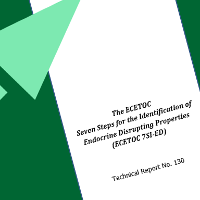Technical Report
31.03.2017
TR 130: The ECETOC Seven Steps for the Identification of Endocrine Disrupting Properties (ECETOC 7SI-ED)
In a Nutshell
In response to the ‘Outline of draft Guidance Document for the implementation of the hazard-based criteria to identify endocrine disruptors’, published by ECHA and EFSA in December 2016 with support from the JRC, the European Centre for Ecotoxicology and Toxicology of Chemicals (ECETOC) has developed science-based guidance showing how the ECHA and EFSA outline to identify endocrine disrupting properties may be put into practice. The Outline of Draft Guidance Document states its intention is to ‘… provide guidance for the implementation of the scientific criteria concerning the hazard-based identification of endocrine disruptors in the context of [the plant protection products and biocidal products] Regulations (EC) No 1107/2009 and (EU) No 528/2012. The Guidance is intended be suitable for both applicants and regulatory authorities.’ The Outline goes on to say that ‘…the endocrine disruptors identification step will be based exclusively on the evaluation of the relevant hazardous properties of a substance.’ Therefore, ECETOC has focused its expertise on providing input for consideration under Section V of the ECHA and EFSA outline ‘Hazard identification strategy for endocrine disrupting properties’. This has resulted in the development of the ECETOC Seven Steps for the Identification of Endocrine Disrupting properties (ECETOC 7SI-ED). The ECETOC 7SI-ED, that covers human and environmental health, focuses on how to use a weight-of-evidence (WoE) approach to assess available information, to integrate it and determine its sufficiency to conclude on the endocrine disrupting properties of a substance. For this conclusion, the ECETOC 7SI-ED builds on the WHO/IPCS (2002) definition of an endocrine disruptor (ED) and its three components. It offers guidance on how to evaluate and integrate information on each of the three components of the definition of an ED, i.e. how to consider 1) available apical studies to identify adverse effects that may be endocrine mediated; 2) (non-) endocrine activity data and 3) the biological plausibility that these are linked by a specific endocrine mode-of-action (MoA). The ECETOC 7SI-ED is based on robust scientific principles and has been designed to be practical and transparent in its utility with the framework being presented as a series of discrete logical steps, each of which is supported by a clear set of questions and considerations to guide decision-making. The ECETOC 7SI-ED applies existing relevant scientific concepts and established best practice frameworks and methodologies e.g. OECD EDTA CF (2012); OECD GD No. 150 (2012); the WHO/IPCS MoA Frameworks, the JRC ToxR Tool and ECETOC TR 106 (2009). In the Technical Report, the seven steps of the ECETOC 7SI-ED are presented as both text and schematically with further guidance on how to address each step. By following this process, the data for any regulated substance can be transparently organised and evaluated to reveal the WoE available, its strengths and uncertainties, to compare with the WHO/IPCS (2002) definition of an ED. This enables a conclusion to be drawn on whether, or not, a substance meets the regulatory definition. The next step for any substance that meets the ED definition criteria is to undergo a comprehensive hazard and risk assessment, including potency and exposure assessment, for which guidance already exists yet is beyond the scope of this document. READ ONLINEThe ECETOC 7SI-ED is recommended as a tool to assess whether or not a substance possesses endocrine disrupting properties. It is based on robust scientific principles and has been designed to be practical and transparent in its utility with the framework being presented as a series of discrete logical steps, each of which is supported by a clear set of questions and considerations to guide decision-making.
Reference
TR130: The ECETOC Seven Steps for the Identification of Endocrine Disrupting Properties (ECETOC 7SI-ED) Published March 2017 ISSN-2079-1526-130 (online) D-2017-3001-249
